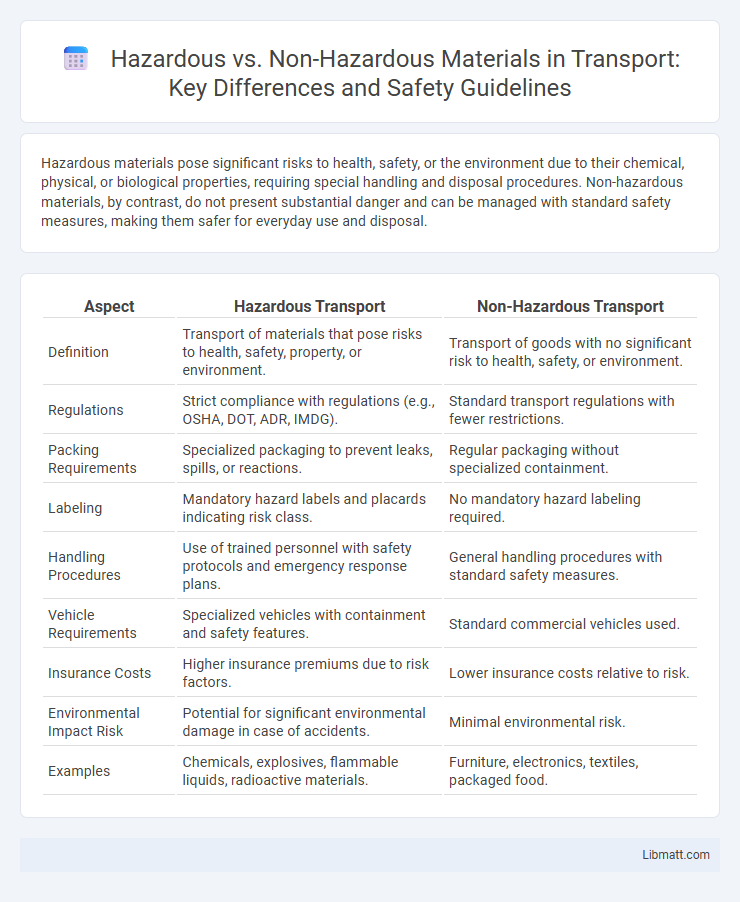Hazardous materials pose significant risks to health, safety, or the environment due to their chemical, physical, or biological properties, requiring special handling and disposal procedures. Non-hazardous materials, by contrast, do not present substantial danger and can be managed with standard safety measures, making them safer for everyday use and disposal.
Table of Comparison
| Aspect | Hazardous Transport | Non-Hazardous Transport |
|---|---|---|
| Definition | Transport of materials that pose risks to health, safety, property, or environment. | Transport of goods with no significant risk to health, safety, or environment. |
| Regulations | Strict compliance with regulations (e.g., OSHA, DOT, ADR, IMDG). | Standard transport regulations with fewer restrictions. |
| Packing Requirements | Specialized packaging to prevent leaks, spills, or reactions. | Regular packaging without specialized containment. |
| Labeling | Mandatory hazard labels and placards indicating risk class. | No mandatory hazard labeling required. |
| Handling Procedures | Use of trained personnel with safety protocols and emergency response plans. | General handling procedures with standard safety measures. |
| Vehicle Requirements | Specialized vehicles with containment and safety features. | Standard commercial vehicles used. |
| Insurance Costs | Higher insurance premiums due to risk factors. | Lower insurance costs relative to risk. |
| Environmental Impact Risk | Potential for significant environmental damage in case of accidents. | Minimal environmental risk. |
| Examples | Chemicals, explosives, flammable liquids, radioactive materials. | Furniture, electronics, textiles, packaged food. |
Introduction to Hazardous and Non-Hazardous Materials
Hazardous materials pose risks to health, safety, and the environment due to their chemical, physical, or biological properties, requiring strict handling and disposal protocols. Non-hazardous materials lack these dangerous characteristics and are generally safe for routine use and management. Understanding the distinction between hazardous and non-hazardous materials is crucial for ensuring Your safety and regulatory compliance in various industries.
Key Differences Between Hazardous and Non-Hazardous Substances
Hazardous substances pose significant risks to health, safety, and the environment due to their toxic, flammable, corrosive, or reactive properties, requiring strict regulatory controls and specialized handling procedures. Non-hazardous substances lack these dangerous characteristics, presenting minimal risk and typically subject to less stringent regulations. The primary distinctions lie in their chemical composition, potential impact on human health and ecosystems, and the necessary safety measures for storage, transportation, and disposal.
Legal Definitions and Regulatory Standards
Legal definitions of hazardous and non-hazardous materials are established by regulatory bodies such as OSHA, EPA, and DOT, providing specific criteria based on chemical properties, toxicity, and environmental impact. Hazardous materials are identified by characteristics including flammability, corrosivity, reactivity, and toxicity, subjecting them to stringent handling, labeling, and disposal regulations under laws like the Resource Conservation and Recovery Act (RCRA) and the Hazardous Materials Transportation Act (HMTA). Your compliance with these legal definitions and regulatory standards ensures safety, reduces liability, and meets federal and state requirements during storage, transportation, and disposal processes.
Common Types of Hazardous Materials
Common types of hazardous materials include flammable liquids like gasoline, corrosive substances such as acids and bases, and toxic chemicals like pesticides and heavy metals. Infectious agents, radioactive materials, and explosive compounds also pose significant risks in various industries. Proper identification and handling protocols are essential to mitigate the dangers associated with these hazardous materials.
Examples of Non-Hazardous Materials
Non-hazardous materials include everyday substances such as paper, plastic, glass, and most household waste that pose little to no risk to health or the environment. These materials are often recyclable or biodegradable, making them safer for disposal and handling. Understanding the distinction helps ensure your waste management practices comply with regulations and promote environmental sustainability.
Health and Environmental Impacts
Hazardous materials pose significant health risks such as respiratory problems, skin irritation, and long-term diseases like cancer due to their toxic chemical properties. These substances also cause severe environmental damage, including contamination of soil, water, and air, disrupting ecosystems and harming wildlife. Non-hazardous materials generally present minimal health threats and lower environmental impact, making them safer options for your workplace and community.
Storage and Handling Requirements
Hazardous materials require specialized storage conditions such as ventilation, temperature control, and secure containment to prevent leaks, spills, or reactions, whereas non-hazardous materials can often be stored with standard safety measures. Handling hazardous substances mandates the use of personal protective equipment (PPE), strict protocols, and training to minimize exposure risks, while non-hazardous materials generally involve less stringent procedures. Understanding these distinctions ensures your facility complies with safety regulations and protects personnel effectively.
Disposal Methods and Best Practices
Hazardous waste requires specialized disposal methods such as incineration, chemical treatment, or secure landfilling to prevent environmental contamination and human health risks. Non-hazardous waste can often be disposed of through conventional means like recycling, composting, or standard landfill use, reducing ecological impact with proper segregation. Ensuring your disposal practices comply with regulatory guidelines and prioritize waste minimization helps safeguard communities and ecosystems effectively.
Labeling, Signage, and Safety Protocols
Hazardous materials require specific labeling and signage, such as GHS pictograms and hazard statements, to clearly communicate risks and ensure compliance with OSHA standards. Non-hazardous materials typically have simpler labeling requirements, focusing on product identification rather than safety warnings. Implement safety protocols tailored to the material type, ensuring your team follows appropriate handling, storage, and disposal procedures to minimize risks in the workplace.
Mitigating Risks and Ensuring Compliance
Mitigating risks associated with hazardous materials requires strict adherence to regulatory guidelines such as OSHA and EPA standards to ensure workplace safety and environmental protection. Non-hazardous materials, while less regulated, still demand proper handling and documentation to maintain compliance and avoid potential liabilities. Incorporating comprehensive training for your staff on classification and safe management practices significantly reduces incidents and supports regulatory compliance.
hazardous vs non-hazardous Infographic

 libmatt.com
libmatt.com